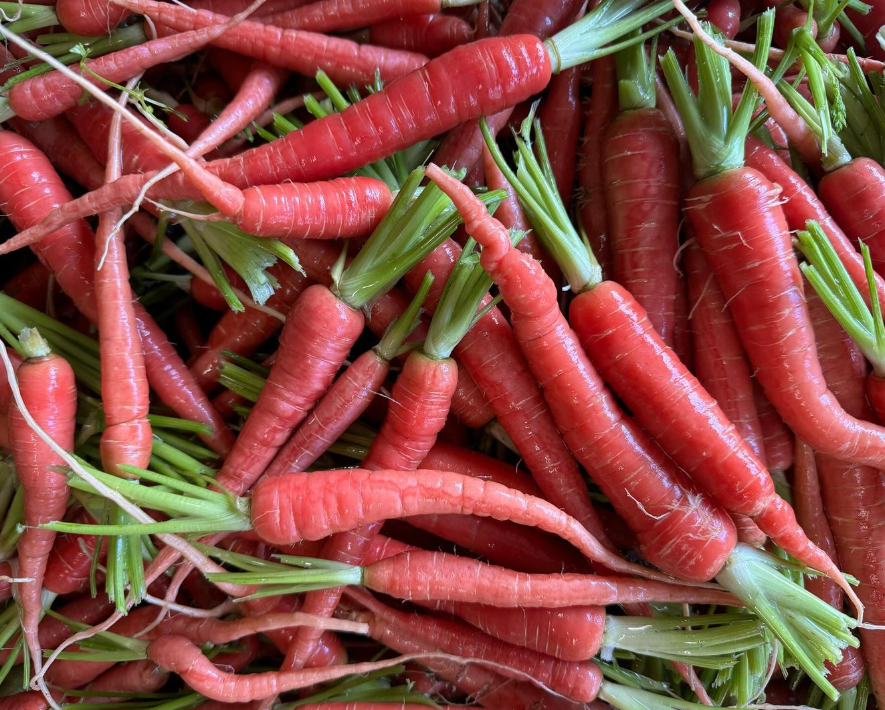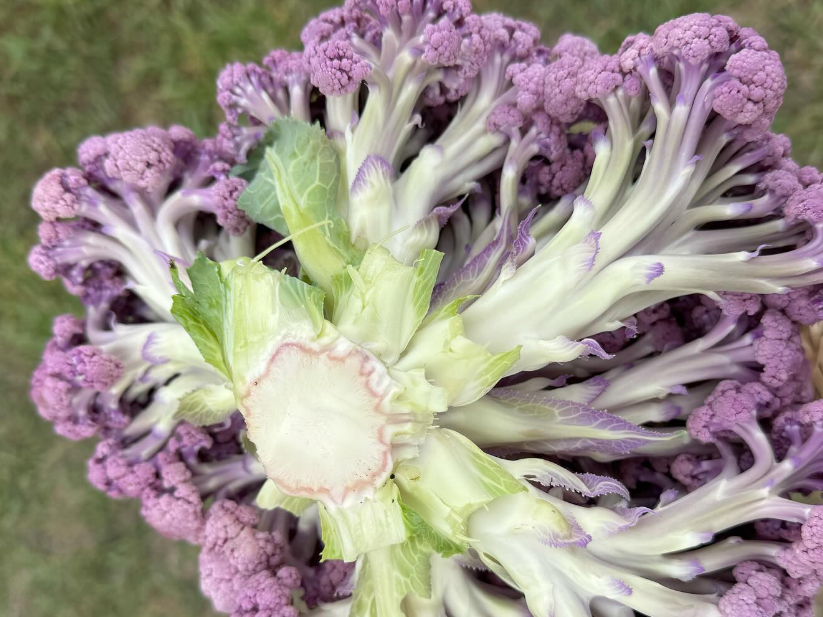
Esoterra Culinary Garden

Audio By Carbonatix
“Every day, every week, every moment is so exciting – it’s like the Thanksgiving Day Parade here,” Mark DeRespinis says as he walks through rows of Mokum carrots, ice lettuce and cucamelons at Esoterra Culinary Garden, a small, 1.5-acre farm in Boulder that grows both classic and exotic produce for many of the metro area’s best restaurants.
DeRespinis, the eccentric, charismatic, Wonka-like genius behind the garden, is giving a tour to me and a group of about forty other lucky lottery winners who scored the chance to attend an event hosted by Meadow Lark Farm Dinners.
I’m visiting the farm for the second time, and as much as I’m excited about the food being served by former Tavernetta pasta maker Jessica Essen, it’s DeRespinis I’m most excited to talk with, and his passion for his garden is enthralling. As he shouts out names of vegetables I’ve never heard of, offering them in every color of the rainbow, I’m captivated by his enthusiasm for all things vegetal.
“We are on the farm at such a magical time, the transitional night between summer and fall. These tunnels are the intersections between summer, fall and winter,” DeRespinis explains as we navigate through the 300 or so garden beds at Esoterra.
Will you step up to support Westword this year?
At Westword, we’re small and scrappy — and we make the most of every dollar from our supporters. Right now, we’re $21,500 away from reaching our December 31 goal of $50,000. If you’ve ever learned something new, stayed informed, or felt more connected because of Westword, now’s the time to give back.
The farm isn’t open to the public, but its team of approximately fourteen people provides produce for top spots such as Tavernetta, Bar Dough, A5, Somebody People, Michelin Bib Gourmand pick Hop Alley, Stellar Jay and Pasque at the new Populus Hotel, and three of Colorado’s Michelin-starred eateries: BrutÁ¸, the Wolf’s Tailor and Frasca.
“It has taken a long time to build these relationships,” DeRespinis admits. “They are very important to us. … It’s all about having relationships based on trust with these chefs.”
“Mark and his produce have become the lifeblood for menus around Denver,” says Hop Alley executive chef Geoff Cox. “I’ve seen a seismic shift in quality over my years of cooking and dining in Denver, and Mark’s nutrient-rich soil is at the forefront of so much of that change. Denver’s recent prominence on the national dining scene owes itself to Esoterra Farms as much as any single entity I can think of. A chef is only as good as the ingredients they use, and Mark and his team have armed restaurants with the firepower to wow every diner in attendance.”

The original Folk-Victorian style house on the Hartnagle Farm property.
M.G. Marini
Planting the seed
DeRespinis started his journey into agriculture in New Mexico, where he worked on a farm at the Mineral Springs Resort in Ojo Caliente. In 2018, he moved to Colorado with his wife, Tara Lanich-LaBrie, who is the author of Foraged & Grown and runs the popular herbal-centric Instagram account @themedicinecircle.
They leased land from the McCauley Family Farm in Longmont and stayed there for two years until the City of Boulder offered DeRespinis the chance to farm the land on the old Hartnagle Farm through its stewardship program – a move that was important to him. “It’s all about bringing it home and rebuilding a local economy,” he notes. For the next year, he slowly transitioned his garden to the new land, and Esoterra Culinary Garden was born.
Establishing roots
The land on the Hartnagle Farm was far from perfect when DeRespinis showed up. Most of the historic farm structures still stand today, including the famed folk-Victorian-style house built in 1898 by preacher Frank DaMetz, who sold the property during the Great Depression to Jacob Hartnagle. At the time, it included ninety acres of farmland.
For the next sixty-plus years, DaMetz and his wife, Bertha, farmed mostly sugar beets on the property and housed dairy cows. (Fun fact: One of their sons, Ernest Hartnagle, is credited as the pioneer behind Australian Shepherd dog breeding in America as the founder of Las Rocosa Australian Shepherds.)
The family continued operations on the farm until the early ’80’s, then sold the land to the City of Boulder after Bertha died in 1996. The farm was leased to others before DeRespinis took it on, but the land hadn’t been well maintained. “It took a lot of love and attention,” he notes. “We had to heal our relationship with the land.”
That included working with the city to retrofit all the buildings on the property with support and pouring concrete in certain areas, as well as making the structures compliant for food safety. The Esoterra team also built a greenhouse, planted apple and plum trees, and introduced thirty beehives. “We don’t take anything from the land; we give,” DeRespinis says.

Chefs love playing with ingredients like these sweet red carrots.
Esoterra Culinary Garden
A blossoming business
Over the last few years, Esoterra has become an integral part of Denver’s fine-dining scene because of its ability to offer consistent produce in fairly large quantities, meaning chefs are able to keep certain dishes on the menu for months at a time.
DeRespinis accomplishes that by using modern techniques such as succession farming – planting new plants in the same holes the same day you pull out the old ones. “It’s important to leave photosynthesis plants in the ground and to always have something in the soil,” he explains. “The future is always being planted.”
Esoterra is also a no-till farm. Contrary to the popular belief that tilling soil brings more nutrients, DeRespinis believes it is important to leave the roots in the ground. By dialing in this process, Esoterra is creating mineral content and nutrient-dense soil containing probiotics and phytochemicals given off from the plants. This results in a fertile foundation for repetitive planting.
The farm grows up to seventy varieties of vegetables and fruits at a time, with the more popular produce yielding up to 200 pounds each harvest. Since many of the greens start out in individual pods, the team at Esoterra adopted a Japanese method to save time during transplanting in which they sow their rows using paper pods that are connected in a string-like fashion. Using a hand-powered machine, the seedlings are distributed throughout the row and carefully placed in old holes.

Red Veined Sorrel sprouting at Esoterra.
M.G. Marini
Sprouting success
With reverence for all parts of the plant – “roots, shoots, leaves and flowers,” as DeRespinis says – he and his team have carefully curated a selection of flowers, vegetables and fruits that top local chefs love to use.
Operating as a culinary garden means that Esoterra has the option to grow plants such as exotic flowers just for garnishes. DeRespinis knows that every dish is art to the chefs he works with, but the garden’s bounty is more than just beautiful. “My wife and I like to use the hashtag #eatcolor because all of these different colors have different antioxidants,” he notes.
Even as winter approaches, there is a wide variety of colorful produce growing at Esoterra, including red spinach, purple Napa cabbage, golden raspberries, pink celery and green daikon. “The Kyoto red carrots taste like red grapefruit, the deep purples give you almost a blueberry flavor, and the green daikon is like green apples,” DeRespinis says.

Purple sprouting cauliflower is one of the varieties that Esoterra grows in the colder months.
Esoterra Culinary Garden
Seasonal depression
“There is no break between the end of one year and the beginning of the other. Diversity in the garden can happen during any month,” DeRespinis explains.
The greenhouse on the property is set to 92 degrees so it can be used all year long – even in freezing temperatures. Although most of us plant our gardens in spring and late summer, DeRespinis says the cold is the best time of year for sweeter produce and plants with deep colors and crinkles. “We have beautiful chicories right now – one being puntarelle, which has these long hollow fingers that you shock in cold water for bittersweet delicousness,” he notes. “The green daikon we harvest into November – it can withstand temperatures as low as 10 degrees and show no damage. They have this sweetness to them, but also a spicy background. We want you to taste the cold.”
Some of the other produce Esoterra planted for fall and winter includes radishes, sunchokes, shungiku greens, savoy spinach, pea tendrils, green garlic and a variety of brassicas, including purple broccoli and sprouting cauliflower. The Mokum carrot seems to be Esoterra’s most popular crop – it’s planted sixty times a year. “We have winter greens in hidden tunnels that reveal themselves in January,” DeRespinis says.

Puntarelle is a chicory variant.
Esoterra Culinary Garden
The future
“I’m looking forward to revisiting the whole procession again,” DeRespinis says. “What are the new varieties this year?”
Esoterra distributes to about fifty restaurants during the summer, though that number shrinks to just over fifteen during the winter. DeRespinis is always looking to bring in more unique produce, but he admits that’s sometimes a gamble. Still, the more Denver strives to be a burgeoning food city with chefs who not only believe in local products but love to use them in fascinating ways, the more unusual crops DeRespinis is willing to grow on his farm.
He and his team are also working on barn renovations so they will be able to study and test more techniques in an environment that’s accessible year-round. “New things come all the time. I have no patience but stay excited because I get distracted by all the new things,” DeRespinis says.
“It’s great to get to work with someone who is not only an awesome human, but takes his craft and what he does as seriously as we do on the culinary side,” says Russell Stippich, chef de cuisine at the recently opened Osteria Alberico, which is part of the Frasca Hospitality Group. “[Mark] is always bringing in or growing new and interesting veggies that help inspire and motivate me to get new things and new takes on old classics.”
Adds Hop Alley’s Cox, “Esoterra’s impact really can’t be overstated. Like so many restaurants in Denver, we wear our partnership with Esoterra proudly on our sleeve. The entire Denver dining scene owes them infinite praise.”
“It takes chefs to believe in us so we are able to grow more,” DeRespinis concludes. “Now we have these restaurants bring their whole teams to the farm so they can learn about the produce they are serving. … I am absolutely thrilled to be collaborating with the best chefs in the region to bring the most amazing produce from this land to local diners. This is an exciting time for Colorado cuisine.”